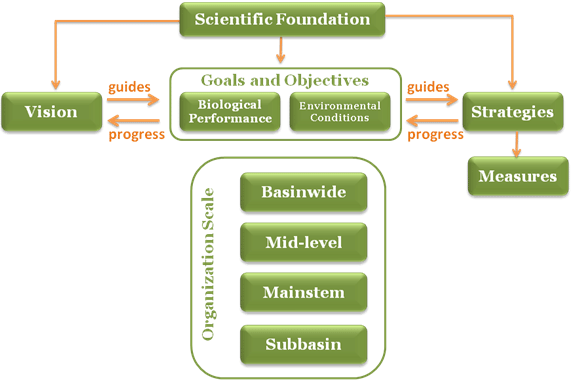The framework is an organizing tool to structure actions guided by this program to protect, mitigate, and enhance fish and wildlife affected by hydropower dams in the Columbia River Basin. The framework connects the program vision, the goals and objectives and implementation through a logical structure. The framework elements along with the principles of adaptive management provide a foundation for adjusting the work done under the program to continue to make progress toward the program vision, goals, and objectives. The framework is applied at all levels or scales of the program, which are described under the geographic structure later in this introduction.
The fundamental elements of the program framework are:
- The vision, which describes what the Council hopes to accomplish in the context of desired benefits provided by the river
- The program goals and objectives, consistent with the vision, which describe the changes in the environment and the biological performance that is needed to achieve the vision
- The strategies, which guide and describe the measures that lead to the desired environmental and biological conditions (program measures are prioritized in the Investment Strategy)
- The scientific foundation and principles, which provide the scientific rationale based on the best available science for why the Council believes certain management strategies and measures will result in particular ecological conditions and why these conditions will affect fish and wildlife populations or communities in a desired way to achieve the vision
- The adaptive management strategy, which guides what information needs to be gathered and evaluated through research and monitoring to assess progress toward program goals and quantitative objectives (this strategy also provides guidance on the reporting of this information and the status of the fish, wildlife, and habitat that it aims to mitigate, enhance, and protect)
An ongoing feedback loop for the fish and wildlife program framework is illustrated in Figure 2. This conveys the importance of constantly applying the information learned through adaptively managing the program and its implementation. Currently, there are three main processes used to adaptively manage the program and implementation of its projects:
- Amending the program at least every five years pursuant to the Northwest Power Act (Act) per recommendations from the region, which are to be based on the best available science
- Regular reviews of the program and current science conducted by the ISAB [see ISAB reports].
- Reviews of program-funded projects by the Independent Scientific Review Panel (ISRP) that inform Council recommendations about project implementation, [see ISRP, Council project recommendations, and CBFish.org] providing the opportunity to adjust project implementation over time to better align with new science and continue to implement sound science

Figure 2. Fish and wildlife program framework


